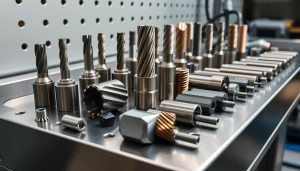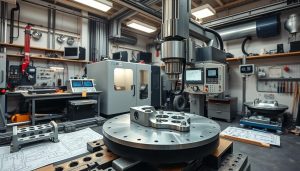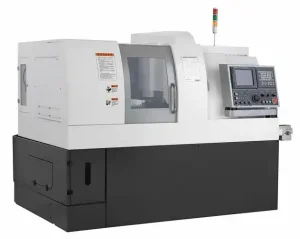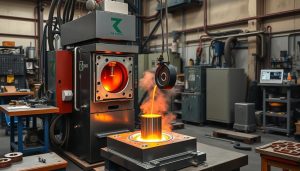Gears are key parts in many machines we use every day. They are toothed wheels that help move power from one shaft to another. This change helps machines work better, whether in cars, factories, or our homes.
In this article, we’ll explore the world of gears. We’ll look at what they are, how they work, and where they’re used. By learning about gears, we can appreciate the engineering that makes our lives easier.

Introduction to Gears
Gears are key in today’s machines and tech. They help move things around efficiently. Knowing about gears helps us see their big role in our lives.
Defining Gears: Essential Components in Machines
A gear is a circular toothed wheel that works with another to move things. You find them in cars, factories, and even clocks. They make sure things move smoothly and do what they’re supposed to.
The Importance of Gears in Modern Technology
Gears are vital in today’s tech. In cars, they help move the wheels smoothly. In factories, they make machines work better. Even in our homes, gears help clocks and blenders work right.
Gears are very important in our world. They help our cars run and our appliances work. Knowing about gears shows us how they make our lives better.
What is a Gear?
At the heart of many machines and mechanical systems lies a crucial component known as a gear. Gears are fundamental building blocks that enable the transfer of motion, force, and power between different parts of a device. But what exactly is a gear, and how does it function?
A gear is a circular, toothed wheel or cylinder that meshes with another toothed component to transmit rotational motion and power. The teeth on the gear’s circumference engage with the teeth of another gear or a rack (a linear toothed bar) to facilitate the desired movement and force transmission. This interconnected system of gears allows for precise control over the speed, direction, and torque of a mechanical system.
The fundamental gear definition encompasses the basic purpose and mechanism of this crucial machine element. Gears are found in a wide range of applications, from simple hand tools to complex industrial machinery, playing a vital role in the operation and efficiency of these devices.
| Key Characteristics of Gears | Description |
|---|---|
| Circular Toothed Wheel | The defining physical feature of a gear, with teeth arranged around its circumference. |
| Power Transmission | Gears enable the transfer of rotational motion, force, and power between components. |
| Speed and Direction Control | The gear ratio and arrangement can be used to adjust the speed and change the direction of motion. |
| Mechanical Advantage | Gears can provide a mechanical advantage, allowing for the transmission of higher torque or force. |
Understanding the fundamental nature of what is a gear and its gear definition is crucial for comprehending the essential role these components play in modern technology and engineering. The versatility and widespread application of gears make them indispensable in a vast array of machines and devices.
Types of Gears
Gears come in many shapes and sizes, each with its own purpose in machines. Spur gears and helical gears are two common types. They are key in today’s technology.
Spur Gears
Spur gears are simple and widely used. They have straight teeth that run parallel to the gear’s axis. This design makes them efficient and durable, perfect for many uses.
They are found in car transmissions and industrial machines. Their simplicity and effectiveness make them a favorite choice.
Helical Gears
Helical gears have teeth at an angle to the axis, creating a spiral. This design leads to quieter operation and can handle more load. They are used in heavy-duty equipment and high-performance cars.
| Gear Type | Tooth Orientation | Advantages | Applications |
|---|---|---|---|
| Spur Gears | Straight, parallel to the axis | Efficient Durable Easy to manufacture | Automotive transmissions Industrial machinery General mechanical systems |
| Helical Gears | Angled, forming a spiral pattern | Smoother operation Higher load-bearing capacity | Heavy-duty industrial equipment High-performance automotive drivetrains Applications requiring greater strength |
Knowing about gear types, like spur gears and helical gears, is key. It helps in creating and keeping mechanical systems efficient. This is important for today’s technology.
Gear Ratios and Mechanisms
Understanding gear ratios and gear mechanisms is key in the gear world. Gear ratios show how many teeth two meshing gears have. This tells us the mechanical advantage and speed of a gear system.
To find a gear ratio, divide the teeth on the driven gear by the driving gear’s teeth. This ratio changes the output’s speed and torque. For instance, a 2:1 ratio means the output gear spins twice for every input gear spin. This doubles the speed but cuts the torque in half.
Gear mechanisms are how gears are set up to get different mechanical benefits. They include:
- Simple gear trains, where two or more gears mesh directly
- Compound gear trains, which use an intermediate gear to connect the input and output
- Planetary gear systems, which feature a central “sun” gear surrounded by smaller “planet” gears
By picking the right gear ratio and gear mechanism, engineers can make efficient and strong systems. These systems are used in many places, like car transmissions and industrial machines. Knowing these basics is essential for making the most of gear technology.

“Gears are the heart of any machine, transferring power and motion with precision and efficiency.”
Applications of Gears
Gears are key in many areas, driving our modern world. They power the automotive and industrial sectors. These devices make operations smooth and efficient.
Automotive Industry
In cars, gears are crucial. They help the engine power the wheels, making driving easy. They also control steering, windows, and wipers.
Industrial Machinery
Gears are also vital in industrial machines. They power construction, manufacturing, and mining equipment. They ensure machines work well, like cranes and conveyor belts.
Gears are heroes in engineering. They make cars shift smoothly and machines work efficiently. They power our world, driving the automotive and industrial sectors.
Gear Design Principles
Designing gears is a key process that needs careful thought. It involves choosing the right materials and optimizing the gear tooth profile. These steps are vital for gears to work well and last long in many uses.
Material Selection
Choosing the right gear material is crucial. It affects the gear’s strength, durability, and performance. Steel, cast iron, aluminum, and alloys are common choices. Each has its own strengths and weaknesses.
When picking a material, consider its load-bearing ability, wear resistance, and cost. These factors help decide the best material for the job.
Gear Tooth Profile
The gear tooth profile is also key in gear design. The teeth’s shape and geometry are important for smooth power transfer. Spur gears, helical gears, and others are designed to reduce friction and noise.
Good tooth profile design is essential. It ensures gears work well in many industrial and car applications.
| Gear Material | Key Properties | Typical Applications |
|---|---|---|
| Steel | High strength, wear resistance, cost-effective | General-purpose industrial machinery, automotive transmissions |
| Cast Iron | Good compressive strength, self-lubricating properties | Heavy-duty industrial equipment, marine applications |
| Aluminum | Lightweight, good corrosion resistance | Aerospace, recreational vehicles, and lightweight machinery |
By focusing on material selection and tooth profile optimization, engineers make gears that work well and last. These steps are key for smooth and precise machinery operation in many fields.
Gear Manufacturing Processes
Making high-quality gears is key in today’s world. They’re used in cars and big machines, and they must work well. To make sure gears are precise, strong, and last long, makers use special methods.
Casting and Machining
Casting is a main way to make gears. It’s when molten metal is poured into a mold to shape the gear. This method is good for making lots of gears because it’s cheap and fast.
After casting, gears get machined. This means they’re turned, milled, and ground to get them just right. This step makes the gears accurate and smooth.
Gear Cutting Techniques
- Hobbing: This special method uses a hob tool to make the gear teeth in one go.
- Shaping: A moving cutter slowly cuts out the gear teeth.
- Broaching: A tool with many teeth cuts the gear teeth as it moves through the material.
These advanced ways of cutting gears make them precise, efficient, and consistent. This is important for many uses.
| Gear Manufacturing Process | Key Features | Typical Applications |
|---|---|---|
| Casting | – Cost-effective for large-scale production – Allows for complex gear geometries | Automotive, industrial machinery, and heavy equipment |
| Machining | – Enables high-precision gear manufacturing – Versatile for a range of gear sizes and materials | Aerospace, precision instruments, and specialty applications |
| Gear Cutting (Hobbing, Shaping, Broaching) | – Specialized techniques for creating precise gear teeth – High productivity and repeatability | Automotive, industrial machinery, and power transmission systems |
These gear manufacturing methods help make gears that meet today’s high standards. This is crucial for many gear-dependent applications.
“Gears are the unsung heroes of modern machinery, quietly powering the world around us.”
Gear Maintenance and Troubleshooting
Keeping gears in good shape is key to making machinery last longer and work better. Gears are important in many areas, like cars and big machines. Knowing how to fix common gear issues and doing regular checks can save time and money. It also makes your gear parts last longer.
Common Gear Problems
Gears can have many problems that affect how well they work. Some common issues include:
- Wear and tear: Gears can wear out over time, making them less efficient and noisier.
- Misalignment: If gears aren’t aligned right, they can wear out faster.
- Lubrication issues: Not enough or the wrong kind of lubricant can cause friction and damage.
- Fatigue failure: Gears can crack and fail if they’re stressed too much.
- Environmental factors: Harsh weather, moisture, or dirt can make gears wear out faster.
Preventive Maintenance
To keep your gear systems running well, you need a good maintenance plan. This includes:
- Regular inspections: Check your gear parts often for wear, damage, or misalignment.
- Proper lubrication: Make sure your gears have the right lubricant and follow the maker’s advice.
- Timely replacement: Swap out worn or broken gear parts before they cause bigger problems.
- Environmental control: Keep your gears safe from bad weather, dust, or extreme temperatures.
- Vibration monitoring: Use vibration checks to spot gear problems early and fix them fast.
By taking care of your gear systems ahead of time, you can make them work better and last longer. This means less money spent on repairs and less time waiting for things to get fixed.

Conclusion
In this detailed look at gears, we’ve covered what makes them key in today’s tech. We’ve learned about their basic definition and the many types available. We’ve also seen how they play a crucial role in different fields.
Gears are used in many areas, from cars to big machines. We’ve talked about how they’re made and the care they need. This shows how important they are for everything to work smoothly.
As we wrap up, it’s clear gears are more than just parts. They drive many new ideas and improvements in our world. Knowing about gears helps us explore new tech and make progress.
FAQ
What is a gear?
A gear is a toothed wheel that helps machines move and change speed. It’s key for power transfer in many places, like car engines and big machines.
What are the different types of gears?
Mainly, there are spur and helical gears. Spur gears have straight teeth, while helical gears have angled teeth. Helical gears work quieter and smoother.
How do gear ratios work?
Gear ratios show how many teeth are on each gear. They change the speed and power of the gear. This lets us adjust the gear’s performance for different needs.
What are the common applications of gears?
Gears are everywhere in cars and big machines. They help power the car’s transmission and adjust speed in factories and farms.
How are gears designed and manufactured?
Designing gears means picking the right materials and shapes. They’re made by casting, machining, or special cutting. It depends on what’s needed.
What are the common gear maintenance and troubleshooting techniques?
Keeping gears in good shape is important. We fix problems like wear and misalignment with regular checks and oil. This keeps them running well.





